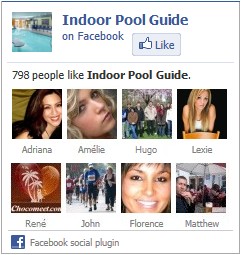
Overview
The purpose of circulating water is simply to make sure that filtered, disinfected water reaches all areas of the pool, and polluted water is removed efficiently. This requires an understanding of the circulation patterns within the pool. Like the circulation rate and turnover period, circulation patterns are influenced by the depth, volume and shape of the pool. Other factors also include the purpose of the pool, for example, free play, lap swimming, wave pools and rivers, since each will have inherent demands on water circulation.
Effective circulation requires attention to overall design; surface water draw-off; inlets and outlets; circulation pumps; flow rates; turnover; and the associated interconnecting pipework.
Surface Water Draw-Off
Unsightly, unhealthy particulate matter will tend to remain on the surface of the water and the majority of organic pollution and contamination is concentrated at or near the surface— irrespective of the mixing effects of the circulation system. Body fats, oils, sunscreens and other oil-based contaminants do not mix with water, and tend to remain at or near the surface. This is also a source of potential infection, and can result in the formation of a ‘scum line’ around a pool.
It is recommended that pools with low bather loads be constructed so that 20 per cent of the surface water is drawn off for filtration. In leisure pools, or those with a higher bather load, this may need to be increased to as high as 80 per cent. Spas, which have a particularly high bather load for the volume of water they contain, should almost always be designed with the higher figure.
There are three basic systems for removing surface water—in decreasing order of efficiency (best to worst): deck level, overflow channels, and skimmers.
Deck-Level (Wet Decks)
This system is becoming increasingly common. The water in the pool is at the same level as the pool surround (wet deck). Some water always floods over the edge and through a grill into a perimeter channel. The water entering these channels is transferred to a balance tank—some balance tanks utilise the perimeter channelling as well. The balance tank acts as a reservoir, storing any excess, and keeping an amount available for when it is needed, such as when the pool users get out, or when a backwash is undertaken, thereby preventing air from being drawn into the filtration plant. Wet decks also reduce wave action and enable maintenance of a stable water level.
Care in the design of the channelling can substantially reduce the noise created by the water flowing into the channel. Attention should also be placed on ensuring that contaminants from the wet deck are not ‘washed’ into the filtration system—there should be an alternative means of cleaning the wet deck, with suitable drainage.
Overflow Channels
These are also known as scum gutters and are common in older pools. Sills around the pool perimeter allow surface water entering them to flow through connecting pipes to the filtration plant. The sills should be uniformly level throughout their length to avoid problems with variations in water level from bather displacement.
A number of refinements are available to ensure that the water remains at the optimum level for effective overflow action. Water displaced by pool users can be accommodated in a balance tank from which it can be returned to the circulation system. The balance tank must be sized to suit requirements for water displacement and backwashing volumes.
An automatic make-up system can be incorporated into a balance tank system, topping up to a given level to keep a minimum amount of water in the system. The automatic make-up system must not be set to fill to the capacity of the balance tank—otherwise it may fill when there are no users, and when users enter the pool, therefore displacing water, the system will be overfull. Overflow channels can be renovated to incorporate a modified wet deck system.
Skimmers
This basic device is installed at intervals around the side of the pool. These act as short, self-adjusting weirs which deal with variations in water level arising from bather displacement. Since their efficiency is far less than the other methods described, their use is only recommended for domestic and low bather loads pools.
Inlets and Outlets
It is critical for safety reasons that inlets and outlets should be strong enough to withstand any likely impact, and be fixed securely.
Inlets
Inlets carry water to the pool and must be arranged so as to ensure that each takes only its required proportion of flow. There should be enough inlets to ensure that the velocity of the water entering the pool does not generally exceed 1.5–2 m/s at depths less that 1.8 m. This should perhaps be as low as
0.5 m/s in shallow or sensitive areas, for example around steps, where turbulence might be a problem. Procedures for dealing with inlets, which are also water features (geysers, sprays and jets), are usually dedicated for the purpose. These are not regarded as an integral part of the circulation system, since they often do not run constantly, but as intermittent features of a centre.
Outlets
These must be arranged so that there is no risk of pool users being drawn towards them, or trapped by them. All suction pipes that are capable of being connected to the full suction pressure of the pump should be connected to at least two separate outlets at least two metres apart, and three metres from the side walls. The velocity of the pumped outlet water should not exceed 0.5 m/s. Outlet covers should be fitted to prevent body parts from being caught by the suction from outlets.

